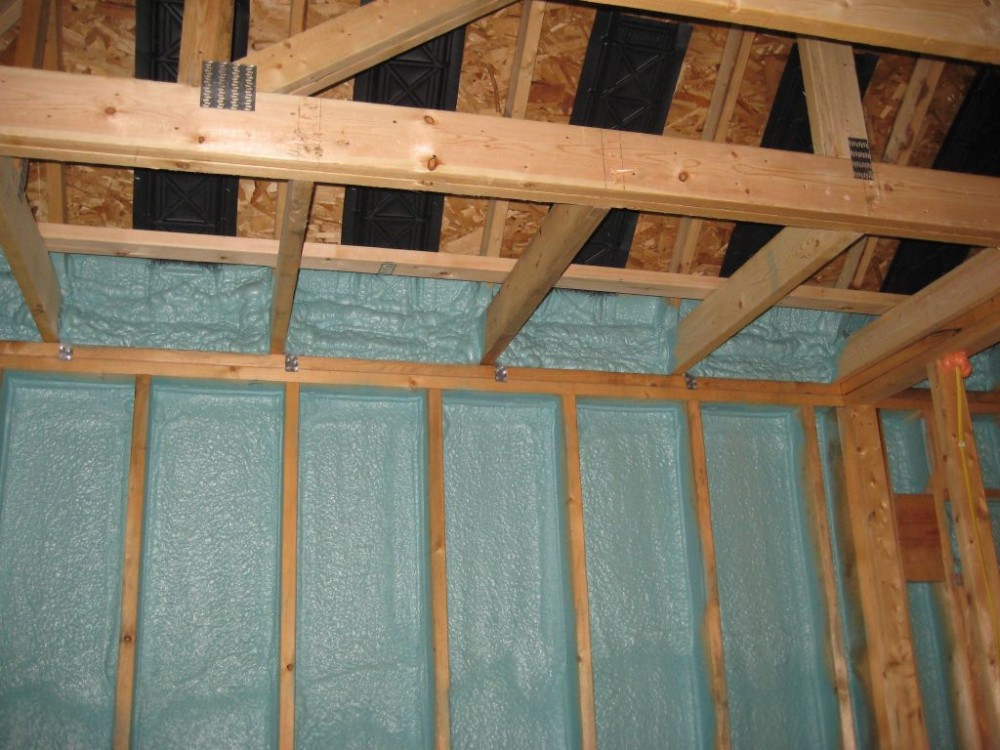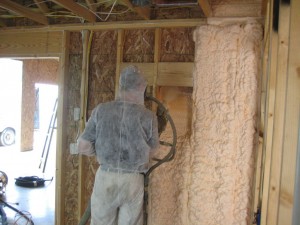
by Rick Duncan, PhD, PE
A wide range of polyurethane foam products is available in various densities and open-cell content, each exhibiting different performance characteristics such as application temperature, moisture resistance and R-value, and compressive strength. While a previous article on The Construction Specifier website examined the basics of sprayed polyurethane foam (SPF), this feature examines how foam selection affects installation characteristics, including the maximum lift thickness per pass and allowable substrate temperatures that affect final product performance.
Surface evaluation
SPF has excellent adhesion to various construction materials including metal, wood, and concrete. Existing surfaces must be dry, and free of oils, grease, dirt, and debris that could affect adhesion.
It is also important to assess weather conditions when applying sprayfoam. The product may be used in various climatic conditions, but it is important to follow the manufacturer’s recommendations. The sprayfoam and anti-fire protective coating should not be installed when there is ice, frost, surface moisture, or visible dampness present on the surface to be covered. Surface moisture can react with SPF chemicals resulting in poor-quality foam or lack of adhesion.
Preparation and priming
In some SPF insulation installations, priming of the substrate surface may be required, especially when applying foam to large metal surfaces. Primers can greatly enhance adhesion between the SPF and existing substrates. Primers can help seal porous substrates and improve adhesion to metal.
Installation of protective coatings and coverings
SPF insulation, like other combustible foam plastic insulations, must be separated from the interior space using a qualified 15-minute thermal barrier. While 12.7-mm (½-in.) gypsum in the walls and ceilings, or 19-mm (¾-in.) plywood subfloor will meet this requirement, other applications of foam may require application of an approved thermal barrier covering or coating. In limited access attics, an ignition barrier coating over the foam may be permitted in both residential and commercial applications.

Cost considerations
At the same R-value, SPF insulation’s installed cost is approximately three times that of fiberglass or cellulose. The installed cost of closed-cell foam is slightly more than open-cell foam at the same R-value.
The difference in cost is due to labor costs as well as the weight of the polyurethane material. For example, to get R-13 of closed-cell foam, approximately 53.3 mm (2.1 in.) thickness is applied—for 0.09 m2 (1 sf) 0.15 kg (0.35 lb) of closed-cell foam. To get R-13 of open-cell foam, 89 mm (3.5 in.) or 0.08 kg (0.18 lb) of foam is required.
While the initial cost is higher, SPF provides an air barrier material (with closed-cell SPF also providing an integral vapor retarder, water barrier, and structural enhancement), which offsets some of the additional expense. There are also additional advantages to SPF including there is no settling or falling out of place—two disadvantages to other insulation options that reduce the building’s thermal performance.
Various applications
SPF insulation can be used to insulate and air-seal any assembly within a building, provided the target substrate is accessible. However, SPF cannot be used to add insulation to cavity walls unless the interior or exterior sheathing is removed. There are other foam products for these concealed-cavity insulation retrofits.
SPF should not be applied to surfaces where the continuous operating temperature exceeds 93 C (200 F)—such as boiler piping and pressure vessels, heaters, and combustion appliance exhaust stacks—as high temperatures degrade the material. Further, open-cell SPF should not be used on exterior surface or below-grade applications where it can contact and absorb water.
As mentioned, SPF, like all foam plastics, should be separated from any interior space using a 15-minute thermal barrier for fire safety. Foam plastics should never be used to insulate the interior surfaces of any HVAC ductwork.
Cellulose and loose-fill fiberglass are ideal for insulating closed-cavity frame walls and adding additional insulation to attic floors. Fiberous insulations are a cost-effective option if the only intent is to meet code-prescribed R-values and air sealing is not required, or is to be addressed with other technologies.
Conclusion
All the installation considerations listed represent basic and essential practices for the installation of SPF for insulation applications. The best way to ensure these procedures and guidelines are followed is to use a professional and experienced SPF contractor. As with any construction trade, a quality contractor will be financially stable, work with trained crews and enjoy a positive reputation with both customers and suppliers. It is also becoming more important for an installer to be professionally certified.
To help ensure SPF quality and safety, most SPF suppliers offer applicator training. Additionally, an International Organization for Standardization (ISO)-compliant professional program has been introduced by Spray Polyurethane Foam Alliance (SPFA) for individual SPF applicators, contractors, and suppliers.
 Rick Duncan, PhD, PE, is the technical director of the Spray Polyurethane Foam Alliance (SPFA), an organization representing contractors, material and equipment manufacturers, distributors, and industry consultants active in the SPF industry. Prior to joining SPFA in 2008, Duncan held the positions of senior marketing manager for Honeywell’s SPF business and global program director for Certain Teed/Saint-Gobain. He holds a PhD in engineering science and mechanics from Pennsylvania State University and is a registered professional engineer in the state. Duncan can be contacted by e-mail at rickduncan@sprayfoam.org.
Rick Duncan, PhD, PE, is the technical director of the Spray Polyurethane Foam Alliance (SPFA), an organization representing contractors, material and equipment manufacturers, distributors, and industry consultants active in the SPF industry. Prior to joining SPFA in 2008, Duncan held the positions of senior marketing manager for Honeywell’s SPF business and global program director for Certain Teed/Saint-Gobain. He holds a PhD in engineering science and mechanics from Pennsylvania State University and is a registered professional engineer in the state. Duncan can be contacted by e-mail at rickduncan@sprayfoam.org.





I’m about to add an addition onto our house. My living room is just a little bit too small for our needs. I don’t know anything about insulation, so I thought I would read up on it. It looks like I’m going to need some help from a professional.
That’s a really good idea for you to look into insulation, Caleb. Often people are hesitant to use spray-foam insulation, and I can’t really see why. The kind described in this article not only seems safe, but beneficial! Thank goodness there are so many options out there. Good luck with the addition to your home, Caleb!